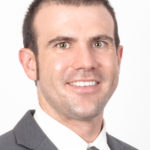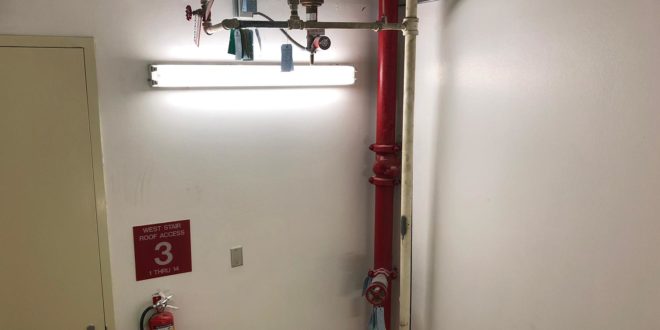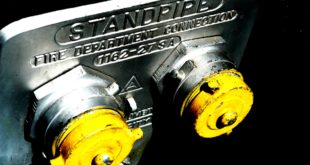Major Updates Made to the Standard
The major updates for the 2019 edition of NFPA 14, Standard for the Installation of Standpipe and Hose Systems, are to align the extracted reference tags with previous editions of other standards along with the requirements in other codes and standards. There are not a lot of technical changes to this edition, but the most significant ones will be covered here. Several of the definitions have been clarified in this edition to hopefully alleviate some confusion. Some terms have been added and some removed to align with the terminology used by other codes and standards.
The most significant change is to sections 7.8.1.2 and 7.10.1.2.1 in which the wording “topmost outlet” was removed and replaced with “connection point.” This clarifies an issue that the American Fire Sprinkler Association’s (AFSA) technical services department staff is asked about frequently in informal interpretation requests.
As noted, there are not a lot of technical changes for this cycle but here are some of the significant changes you will see:
• All references to breezeways (such as section 7.3.2.5) were removed since this is not a term used in building or fire codes.
• Requirements for automated inspection, testing, and distance monitoring devices, meters, and equipment have been added.
– “Where provided, devices, meters, and equipment utilized to perform automated inspection and testing procedures that are not subjected to system pressure shall not be required to be listed.”
– “Where provided, devices, meters, and equipment utilized to perform distance monitoring of system or component status that are not subjected to system pressure shall not be required to be listed.”
• Requirements for automated valves have been added.
– A listed indicating valve with automated controls shall be permitted.
– A listed automated water control valve assembly with a reliable position indication connected to a remote supervisory station shall be permitted.
– An automated water control valve shall be able to be operated manually as well as automatically.
• Manual standpipes shall be permitted in open parking garages where the highest floor is located not more than 150-ft above the lowest level of fire department vehicle access. This has been an International Building Code (IBC) allowance for some time.
• Water-filled piping shall be allowed in areas where the temperatures drop below 40°F when heat-loss calculations performed by a professional engineer verify that the system will not freeze. This correlates with the allowance added to NFPA 13, Standard for the Installation of Sprinkler Systems, in the 2013 edition.
• The required pressure sign shall not be required when the pressure for the system is 150 psi or less.
• The maximum allowed pressure has been updated to 400 psi. Previously, it was 350 psi.
• If the static pressure at a 11/2-in. hose connection exceeds 175 psi, a listed pressure-regulating device is required to limit static and residual pressures at the hose connection to 175 psi or less. Previously, it was 100 psi.
• Section 7.5.1.1, whereby standpipes are not required to be interconnected when approved by the Authority Having Jurisdiction (AHJ) is being added to soften section 7.5.1.
• Section 7.6.2.1 has been pulled out from being a subparagraph of section 7.6.2 and is now section 7.6.3. The existing criteria allows a building that is protected throughout by an approved automatic sprinkler system in accordance with NFPA 13 or NFPA 13R, Standard for the Installation of Sprinkler Systems in Low-Rise Residential Occupancies, to have a combined standpipe size of no less than 4 in. for systems hydraulically designed in accordance with section 7.8.1. This change was needed since section 7.6.2 addresses partially protected buildings.
• Section 7.8.1.1 removes the wording “calculated using Table 8.3.1.3” and replaces it with “determined using the valve manufacturer’s most up-to-date friction loss data.”
• Section 7.8.1.1.1 removes the wording “ … shall be used when published” and replaces it with “values in Table 8.3.1.3 shall be permitted to be used for non-pressure-reducing valves when the … ”
• Section 7.8.1.2 removes the wording “topmost” and replace it with “of the hydraulically most remote 21/2-in. (65-mm) hose connection valve.” This should help alleviate some confusion when calculating the system to clarify the most remote outlets should be calculated.
• Section 7.8.1.2.1 is being added which opens the door to manual system designs that exceed 175 psi inlet demand.
– “The pressure required at the fire department connection for manual standpipes shall not exceed the working pressure of the system components of the standpipe system or sprinkler system when the system is a combined system.”
• Sections 7.10.1.2.1 and 7.10.1.2.2 remove the wording “topmost outlet” and replace it with “connection point.” This should help alleviate any confusion about whether NFPA 14 is requiring two 21/2-in. outlets to be installed at the top of standpipe systems and which outlets should be calculated.
• Section 7.10.1.2.3.1 has a new figure in the Annex in hopes to clarify that when a structure is divided into multiple buildings by a two-hour firewall that common piping must supply all standpipes on the most demanding system, but are not required to be calculated together. Since the 2019 edition of NFPA 14 won’t be published until later this year, we are unable to reprint the figure within this article. Instead, please reference Figure A.7.10.1.2.3.1 “Common Supply Standpipes Calculated” when the standard is published.
• Section 7.11.2 makes a lot of changes to the requirements for drains by adding sections and removing other sections with the main purpose to clarify that main drains are required to be able to be completely opened without causing damage and/or how to locate the discharge locations to achieve this requirement.
• Section 7.12.2 removes the wording “high-rise buildings shall have at least two remotely located fire department connections for each zone” and replaces it with “number of fire department connections.”
• Section 7.12.2.1 removes the wording “a single connection for each zone shall be permitted where acceptable to the fire department” and replaces it with “a minimum of one fire department connection shall be required for any standpipe system.”
• Section 7.12.2.2 has been added to cover the requirements for high-rise buildings since it was removed from section 7.12.2, and also includes buildings or multiple attached buildings with a perimeter that exceeds 900 ft in length. The specific wording was chosen because many jurisdictions have found additional fire department connections (FDCs) are necessary due to single connections being obstructed by parked cars, storage, landscaping, street closures, etc. or damaged making them unusable.
– “Two fire department connections shall be provided for each zone, located either on opposite corners of the buildings where fire department apparatus access is provided or, where not possible, physically separated to the greatest extent possible for the following: (1) High-rise buildings (2) Buildings or multiple attached buildings exceeding 900-ft (274.3-m) perimeter distance.”
• Section 7.12.2.3 has been added to require FDCs to “ … be visible and recognizable from and located within 50 ft (15.2 m) of the street or nearest point of fire department apparatus access.”
• Section 11.7 been changed from Alarm and Supervision Tests to Automated Inspection and Testing Devices and Equipment to align with the allowance of automated inspection, testing, and distance monitoring devices, meters, and equipment in the 2019 edition. The purpose of this section is to maintain automated inspection and testing devices and equipment are as effective as physical and visual inspections and tests.
Along with these changes in the 2019 edition, the 2022 edition of NFPA 14 is going to be reorganized to group relevant information together to limit having to go back and forth between sections in order to find all of the requirements. The reorganizing will also remove redundancies in the hopes to avoid confusion, similar to the purpose of reorganizing the 2019 edition of NFPA 13.
Now that the major changes for the 2019 edition of NFPA 14 have been covered, here are two of the most commonly requested informal interpretations for the AFSA Technical Services Department staff when it comes to previous editions of NFPA 14:
• Are horizontal standpipes and branchlines required to be protected from mechanical and fire damage?
– Only in non-sprinklered high-rise buildings and sprinklered high-rise buildings of Type III, IV, and V construction.
• NFPA 14 (2016 edition) requires in section 7.10.1.1.1 the minimum flow rate for the hydraulically most remote standpipe must be 500 gpm through the two most remote 21/2-in. outlets. Is it requiring two 21/2-in. outlets to be installed at the most remote location, or can the flow be taken from one 21/2-in. outlet at the most remote outlet and flow from one 21/2-in. outlet at the second most remote outlet on the same system (the top landing and landing below) be used together?
– The flow can be taken from the two most remote outlets. If there are two 21/2-in. outlets provided at the most remote location, then those outlets would be used. If there is only one 21/2-in. outlet at the most remote location (the uppermost landing in a stairwell for example) then the second most remote one 21/2-in. outlet provided on the same system would be used as the second most remote outlet (the next landing down in a stairwell to continue the example). This is clarified in section 7.10.1.2 in the 2019 edition by removing the “topmost outlet” and replacing it with “connection point.
ABOUT THE AUTHOR:
 Russ Bainbridge, PE, CFPS, MS, is senior fire protection engineer for the American Fire Sprinkler Association (AFSA). He has a bachelor’s degree in fire protection and safety technology with a minor in emergency management from Oklahoma State University and a master’s degree in fire protection engineering from California Polytechnic State University. Bainbridge has a Professional Engineer license in Fire Protection Engineering in the state of California. He is a member of NFPA’s Certified Fire Protection Specialist (CFPS) Certificate Advisory Group, sits on the Society of Fire Protection Engineers’ (SFPE) Professional Competency & Credentialing and Nominating Committees.
Russ Bainbridge, PE, CFPS, MS, is senior fire protection engineer for the American Fire Sprinkler Association (AFSA). He has a bachelor’s degree in fire protection and safety technology with a minor in emergency management from Oklahoma State University and a master’s degree in fire protection engineering from California Polytechnic State University. Bainbridge has a Professional Engineer license in Fire Protection Engineering in the state of California. He is a member of NFPA’s Certified Fire Protection Specialist (CFPS) Certificate Advisory Group, sits on the Society of Fire Protection Engineers’ (SFPE) Professional Competency & Credentialing and Nominating Committees.
IMPORTANT NOTICE: The article and its content is not a Formal Interpretation issued pursuant to NFPA Regulations. Any opinion expressed is the personal opinion of the author and presenter and does not necessarily present the official position of the NFPA and its Technical Committee.
 Sprinkler Age A Publication of the American Fire Sprinkler Association
Sprinkler Age A Publication of the American Fire Sprinkler Association

